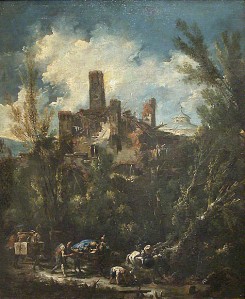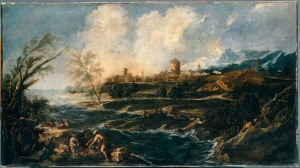The Attraction of Two
It has been almost two months since I last posted something on the blog. Although I started an entry late in November on Alessandro Magnasco (1667-1743), I kept getting interrupted by my university work. When I finally was able to open The Louvre: All the Paintings again, on December 8th, after a three-week interruption, I decided not to go back to Magnasco. Instead, I went farther back, to the start of my Louvre project: I began spending half an hour each day looking at the work or works of one painter and then noting down a few thoughts, without worrying about the blog. Over the past two weeks, I’ve looked at 48 works, bringing my painting total to 599, which means I’m about 20% of the way through the book’s 3,022 works. At this rate, I should finish by December 2019. I wonder whether anyone will still be writing, let alone reading, blogs by then. But raising this question in a blog about the Louvre offers a very different perspective on questions of time: here I am worrying about something that might be obsolete in six years while looking at paintings that have been treasured for hundreds of years. In Dorothy Sayers’ Gaudy Night, Lord Peter Wimsey is humbled when he learns that Harriet Vane, the novelist he loves, has taken his advice about Wilfrid, the male protagonist of her latest mystery. He says, “I shall be honored to go down to posterity in the turn-up of Wilfrid’s trouser.” That’s how I feel: if only I could go down to posterity in the turn-up of the Louvre’s trouser.
This thought has taken me back to the blog; I will stick with it, although I will not attempt a regular schedule until the end of the academic year.
But what to write? During the first week of November, after finishing blog post 25, I managed to look at the work of five painters. Two of the five—Gianantonio Pellegrini (1675-1741), with five paintings, and Alessandro Magnasco, with seven paintings—both suggested promising topics. My first idea was to write about Pellegrini’s Modesty Introducing Painting to the Academy (1733). The title especially attracted me, which has happened before, viz. October’s The Continence of Scipio, and the 1685 painting, Thomyris Immersing the Head of Cyrus in a Vase of Blood, by Mattia Preti (1613-1699), which I wrote about in blog post 19. Unlike these two titles, Modesty Introducing Painting to the Academy doesn’t use familiarly a name unfamiliar to me. On the contrary, every word was familiar: modesty, patience, academy; still, doesn’t it seem surprising that Painting needed to be introduced to the Academy, where one might have supposed Painting would be known? And if an introduction was needed, why would Modesty be the one to conduct the ceremony? Was there some doubt as to Painting’s appropriateness for the Academy?
A little looking around convinced me not to write about Pellegrini. I was assured by the Louvre’s Atlas Database that what I had imagined might be a charming mystery was simply Pellegrini’s profession of modesty on introducing his work to the Académie Royale de Peinture et de Sculpture in Paris, which he joined on December 31, 1733. So, the title of this blog post doesn’t reflect a struggle to choose between two painters who attracted my interest. Rather, it comes from Magnasco, whose work attracted me in many ways that included some element of “twoness”. First, two of his seven paintings in the Louvre mention “two” in their title: Landscape with Two Figures (ca. 1700) and Two Hermits in a Forest (ca. 1730). In both instances, two is used with reference to the number of human subjects in the painting. The first of these paintings, and others by Magnasco in the Louvre, also contain a wonderful balance between two very different elements, one a grouping of human figures performing a task and the other an extensive landscape rich in dramatic natural features. I sometimes find that monumental landscape paintings fail to make a strong connection between natural surroundings and human figures. I wonder if it’s because I find it easy to relate to the natural surroundings—mountains, trees, bodies of water, clouds, expanses of field and sky—and not so easy to relate to the minuscule human figures, who, despite the prominence they usually are given in painting titles, are often unfamiliar to me without further research. I had no such difficulty with Magnasco.
 But I do owe to research my favorite “twoness” about Magnasco. Beginning in his apprentice days, he specialized in adding figures to landscapes created by other specialists. Although Landscape with Two Figures is identified in my Louvre book as the work of Magnasco, a commentary on the French language Louvre website (a commentary not available on the English language website) identifies it as an early example of a longstanding collaboration between Magnasco and landscape painter Antonio Francesco Peruzzini (1643/6-1724), which is also represented in the Louvre by The Mule Driver, also known as The Landscape with Castle (ca. 1710). Magnasco went on after Peruzzini’s death to collaborate with other “paysagistes”.
But I do owe to research my favorite “twoness” about Magnasco. Beginning in his apprentice days, he specialized in adding figures to landscapes created by other specialists. Although Landscape with Two Figures is identified in my Louvre book as the work of Magnasco, a commentary on the French language Louvre website (a commentary not available on the English language website) identifies it as an early example of a longstanding collaboration between Magnasco and landscape painter Antonio Francesco Peruzzini (1643/6-1724), which is also represented in the Louvre by The Mule Driver, also known as The Landscape with Castle (ca. 1710). Magnasco went on after Peruzzini’s death to collaborate with other “paysagistes”.

